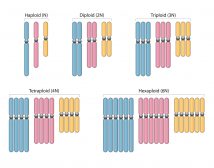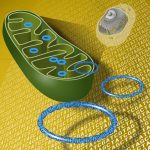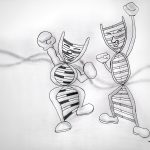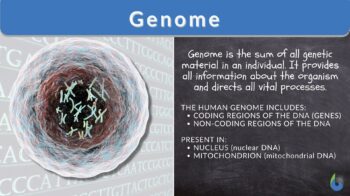
Genome
n., plural: genomes
[ˈd͡ʒiː.noʊm]
Definition: complete set of the genetic material of an organism
Table of Contents
Genome Definition
What is a genome? As defined in biology, a genome is a complete set of deoxyribonucleic acid (DNA) within a living cell. The human cell generally contains up to 3 billion base pairs of DNA, which makes the genome. Other viruses have their genetic material in the form of ribonucleic acid (RNA).
While genomics is a term that refers to the study of gene functions, structure, analysis, regulation, mapping, editing, and evolution. These studies give information that helps in understanding human health in addition to diseases related to mutations and inheritance.
DNA is the unit forming genome. It carries all information that makes the body. The gene is a part of DNA that has instructions for making a certain protein or multiple proteins. Genes are present on chromosomes found inside the nucleus of a living cell. Generally, every living cell contains about 3 billion base pairs of DNA which is a complete copy of the genome in a body. There are 23 pairs of chromosomes carrying genes responsible for the synthesis of a protein with the aid of other messenger molecules and enzymes. Moreover, other noncoding DNA segments such as enhancers, promoters, and terminators have structural and regulatory roles; they form the majority of the eukaryotic genome.
The DNA molecule is composed of a double helix that is formed of nucleotides. Each nucleotide is made up of deoxyribose sugar, phosphate group, and nitrogenous base, the nitrogenous base is named adenine (A), guanine (G), cytosine (C), or thymine (T).
Each strand of DNA is formed by linking two nucleotide bases by a phosphodiester bond, while two DNA strands are connected together by a hydrogen bond that forms the double helix structure.
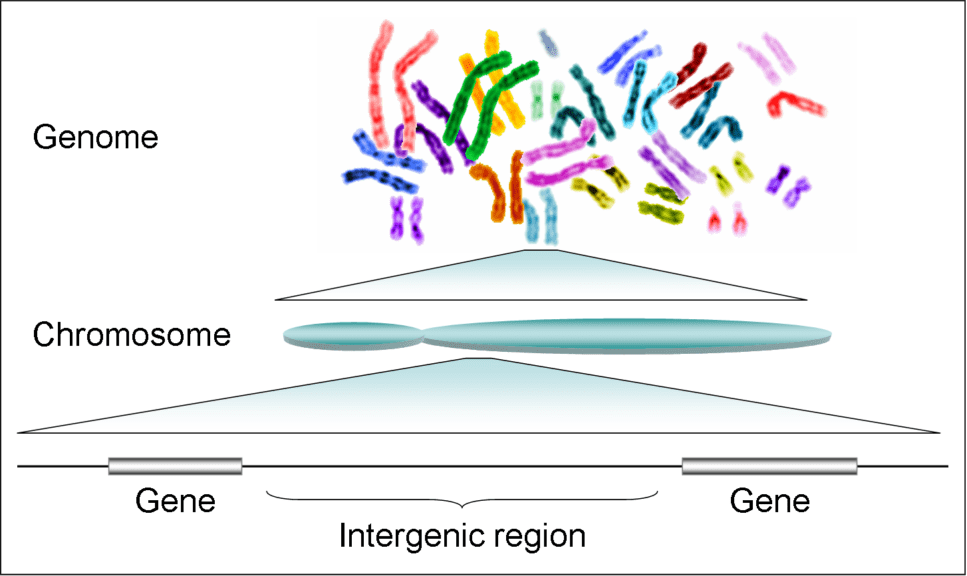
Basically, one of the enzymes copies the information on the DNA of a gene into a messenger ribonucleic acid molecule (mRNA). Then, it travels outside the nucleus into the cytoplasm carrying the information to be read by ribosomes. This information directs ribosomes to link small amino acids together forming a specific protein.
Proteins are important components of many biological structures, such as tissues and organs. They form hormones and enzymes that carry signals between different cells as well as control chemical reactions in the body. Abnormal mutations may occur in the DNA of a cell producing abnormal proteins which may disrupt normal processes in the body and lead to the formation of cancers.
To conclude, DNA carries all information responsible for building the entire body through carrying instructions necessary for making proteins. Each gene of the genome (about 20,000 to 25,0000 genes) codes for about 3 proteins.
For the continuity of life, the genome transfers from one cell to another during cell replication and differentiation to ensure the preservation of life. The genome has functional, structural, and adaptability roles. It is transferred through generations to conserve species.
How to define genome? The human genome meaning is the complete content of genes in a single set of chromosomes, it is made up of about 3 billion base pairs or about 350000 genes of DNA base pairs. The human genome project was used to generate a database of genomes available to the public. It identified the sequence in the human DNA in terms of chemical base pairs. However, the project sequenced the euchromatic regions only in a genome and did not sequence the heterochromatic regions in telomeres or centromeres. This database is used in biomedical studies by providing genome examples such as genetic variations that can be studied to understand diseases related to genetic mutations, such as cancer. Other researchers aim to discover the relationship between genetics and disease or health. Learning more about the human genome project is a fundamental step in mastering genetics.
Genome is the complete set of genetic material in an organism. According to Oxford Dictionary, the term genome is a portmanteau of the words gene and chromosome. However, Hans Winkler, a German botany professor, is the first to use the term in 1920. In molecular biology and genetics, the term pertains to the complete set of the individual’s genetic material. The genome of eukaryotes is contained in a single, haploid set of chromosomes. The genome of bacteria is contained in a single chromosome whereas the genome of viruses is in the DNA or RNA.
Sequencing and Mapping
Genome sequencing and genetic mapping are different technologies. However, both of them can produce the same results. The human genome project goals included building a series of maps of chromosomes at high resolution.
Genetic mapping
Genetic mapping includes dividing large chromosomes into smaller units to be characterized and propagated, then chromosomal units are ordered (mapped) in positions corresponding to their locations on the chromosome. After mapping, the sequence of each base of ordered fragments of DNA is determined. Finding genes in a DNA sequence and developing tools using this information to help in studying medicine and human biology.
The genetic order, i.e., the spacing between the genes on chromosomes, and other markers are described in a genome map. Genome maps are available in different ranges of resolution or scaling. Physical maps are available to describe the chemical properties of the DNA. Genetic maps are useful in detecting inherited unique characteristics among chromosomes as genetic markers. However, only polymorphic markers are used in mapping since they are easily detectable among different individuals.
A genetic map is useful in following the DNA marker in affected patients and its inheritance. It is also useful in determining the exact location of chromosomes of different genetic diseases such as cystic fibrosis, X syndrome, and sickle cell disease. For example, sickle cell anemia is caused by an alteration in one of the chromosomes, so it is easily predictable and can be detected simply.
With the aid of the human genome project, clinicians and scientists can study different genetic and environmental factors contributing to the development of certain diseases such as cancers, heart diseases, and diabetes.
Even though pharmacogenomic research consumes a considerable amount of effort, time, and funding, genome-based diagnosis and screening tests provide rapid, targeted, and tailored drug therapy for patients. Genome Medical is a health company that uses genomics and genetics to make personalized, targeted, and proactive healthcare and medicine.
Genome sequencing
What is genome sequencing? Genome sequencing is sequencing a genome to provide information about the genetic complement of an individual. It is used to simply determine the base sequence in a DNA strand. Researchers do not usually identify both bases in a pair since they are complementary to each other. The most common method of sequencing now is by synthesizing the DNA of interest from the gene using DNA polymerase. A fluorescent label is used to detect the incorporation of different nucleotides and consequently determines the genetic sequencing.
Since no two individuals have the same genetic sequence (except identical twins), a gene sequence derived from an individual is a blueprint that includes the basic genetic sequence of a chromosome as well as characteristic sequences of each individual. Therefore, by comparing different genetic sequences, the basic genome, the disease-causing sequences, genes responsible for mutations, and genes responsible for variations among individuals will be apparent.
Genetic mapping and genome sequencing are two different terms even though they nearly yield the same final product. Generally, genome sequencing is more useful for basic science. Whereas genetic maps are useful in describing marker order along a chromosome.
Viral Genomes
Viruses are widely present on earth, they have the ability to infect almost any living organism including animals, plants, insects, and other living cells. Viruses play a major role in ecology that can affect the climate. Viruses contain nucleic acids covered by a protein package. They can invade the cell and use its machinery to replicate its genome. The viral genome varies extraordinarily in terms of the type of nucleic acid, its complexity, size, and transfer pathways. The viral genome can be:
- RNA or DNA
- single-stranded or double-stranded
- monopartite or multipartite
- circular or linear
- short or long
This diversity contributes to the expression and replication of the viral genome in the host cell by different strategies.
Prokaryotic Genomes
Prokaryotic genomes are found in bacteria and archaea, it is compact so that all their DNA is functioning. The prokaryotic genome is usually present in a circular, single chromosome.
Since all the prokaryotic DNA is functioning, so the metabolic capacity of prokaryotic cells and their ability to produce enzymes and proteins is related to the size of the genome.
Prokaryotic chromosomes may replicate faster than those of eukaryotes so a prokaryotic cell may contain multiple chromosomes. Moreover, some bacteria have part of their genome carried on a circular plasmid. The plasmid usually carries non-essential genes such as those responsible for resistance and production of toxins.
Eukaryotic Genomes
Eukaryotic genome size varies significantly among different species. Therefore, eukaryotic cells may contain non-coding genes that are not involved in the production of proteins. Non-coding genes may be more than coding genes in some eukaryotes due to the presence of transposable elements and repetitive DNA.
Eukaryotic genomes are composed of several haploid, single sets of chromosomes divided linearly. Each eukaryotic chromosome contains a double linear DNA molecule.
A human cell contains 22 autosomes from each parent, making 2 copies of autosomes. In addition to 2 sex chromosomes, making the cell diploid. Unlike gametes which are sperms, ova, and pollens, they carry only half the number of chromosomes in a diploid cell. In addition, small organelles in the cell such as mitochondria and chloroplast have their own genome. The plastome and mitochondrial genome are usually circular since they resemble the genome of bacteria they have originated from.
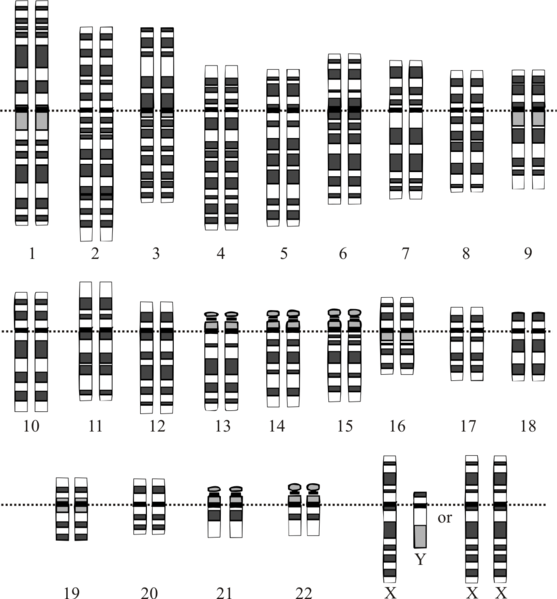
Genome Size
The size of a genome is the total amount of DNA in a single copy of a haploid cell. the genome size is usually described by the c-value where the larger the c-value, the greater the number of genes in a genome. So, the prokaryotic genome is directly influenced by the gene number, where the size of the eukaryotic genome is not related to its size since the eukaryotic genome contains a large number of non-coding genes.
Variation among eukaryotic genomes accounts for the amount of non-coding genes since eukaryotes have sequenced the genome between ~6,000 and ~30,000 coding genes for protein synthesis. The number of coding genes is less than the degree of variation between genes by about 10-fold.
The human genome size ranges from 50,000,000 to 300,000,000 base pairs. It contains about 3 billion base pairs in 23 pairs of chromosomes inside the nucleus of the human cell. Consequently, each chromosome contains genes ranging from hundreds to thousands, they carry information necessary for protein synthesis. Every 30,000 genes are responsible for making about three proteins.
The size of a genome is not related to the size or complexity of an organism. For example, humans and nematodes (those that are microscopic) have almost the same genome size. Conversely, rice has fewer genes. Thus, the size of a genome varies between different species. For example, invertebrates and birds have relatively small genomes whereas amphibians and fish have intermediate genomes.
Genome size usually reflects the amount of repetitive DNA and the expansion of the genome. Moreover, the presence of transposable elements results in great variation in the genome size. The genome size may be increased by (1) the insertion of a new sequence in a genome, (2) duplication of an existing gene, or (3) polyploidization. Recombination may increase or decrease the size of DNA whereas deletion may decrease the genome size.
To compare the total number of chromosomes in different eukaryotes, read: Chromosome Number in Eukaryotes
Genomic Alterations
All cells in an organism contain an identical genome to other cells since all cells in the body originated from the same cell. However, sometimes mutations arise due to errors in copying DNA during cell proliferation or due to exposure to external mutagens leading to the formation of cancers. Mutagens cause cancers by stimulating cells to divide quickly at a rate higher than normal and invade the surrounding area.
Gene mutations may accumulate in the cell over many years before it is altered. The formation of many mutations in a cell may stop its normal function and it will become cancerous. Somatic or acquired mutations are those that build up in a cell due to genetic damage over years. Genomic alteration in a cell may occur due to exposure to environmental toxins such as radiation, certain viruses such as human papillomavirus, which is the major cause of cervical cancer and aging.
Recent genomic studies can reveal the susceptibility of individuals to certain diseases such as heart diseases, cancers, and diabetes by tracking the alteration in their genome. These predisposing genetic factors can be passed throughout generations which explains the susceptibility of some races to certain diseases.
Newer genomic techniques such as microarray analysis and RNA protein sequencing aim to cure or manage inherited genetic diseases or those arising from genetic mutations.
DNA alterations are passed through generations, with the continuity of this process, racial changes will appear causing diversity among races of the same species. This process affected the discovery of human history, as well as the evolution of new species, traits, and strains. The ability of an organism to adapt to unfavorable environmental factors through changing its genome is known as genome plasticity.
Genome plasticity is a common feature in prokaryotic organisms as a method to adapt to environmental changes and this occurs by exchanging their genes with individuals or by acquiring genetic material for survival from the environment.
On the other hand, the genome of eukaryotes is modified or damaged by the action of mutagens such as ultraviolet radiation resulting in a functional, structural, or physical change in the genome or a gene.
Genome Evolution
Genomes are not only some of the genes in a body, the genome carries traits that can be studied and measured to get details and references. Characteristics of different genomes are compared such as their number, size, and use of codons in order to study the mechanism which produced the greatest variation among organisms.
The genome changes its size or structure over time in a process known as genome evolution. Studying genome evolution involves analysis of the genome, studying the ancient genome, and genomic parasites. Genome evolution is a constant and ongoing process.
Prokaryotic gene evolution occurs either by horizontal gene transfer, mutation, or sexual reproduction in sexually reproducing species as bacteria. Some prokaryotes acquire new genes by the process of conjugation where the plasmid of a prokaryote is introduced into another to transfer new genes to it, these genes include antibiotic resistance.
Transduction is another mechanism by which a prokaryotic genome changes where a bacteriophage inserts a new DNA sequence into the genome of bacteria. Some prokaryotes reproduce “sexually” whereby their DNA is transferred from one cell to another by transformation.
Generally, free bacterial cells have evolved a larger and more complex genome throughout the years in order to enhance their adaptability to the surrounding environment and its changing conditions. On the other hand, the parasitic bacterial genome is less complex and smaller since they get their nutrients from the host, so they don’t need genes to encode for nutritional processes.
The eukaryotic genome changes over time mainly through sexual reproduction that allows two different chromosomes to share their genetic material resulting in the production of new genetic sequences, and consequently new traits. Moreover, the eukaryotic genome might be affected by external environmental factors such as radiation, heat, and toxins. Another mechanism by which the eukaryotic genetic sequence changes and evolves is the movement of transposable elements, which are small fragments of DNA that jump from one place to another across the DNA producing new genetic sequences. Transposons are considered a driving force in eukaryotic genome evolution since they can disrupt the gene function, produce new genes, or change the function of an existing gene.
Try to answer the quiz below to check what you have learned so far about the genome.
References
- Genome. Oxford Dictionary (Online). Retrieved from http://www.oxforddictionaries.com/us/definition/american-english/genome.
- Winkler, H. L. (1920). Verbreitung und Ursache der Parthenogenesis im Pflanzen- und Tierreiche. Jena: Verlag Fischer.
- A brief guide to genomics. Genome.gov. (n.d.). Retrieved from https://www.genome.gov/about-genomics/fact-sheets/A-Brief-Guide-to-Genomics.
- Lyseng, R., (2017, December 29). Genetic mapping vs. genome sequencing. The Western Producer. Retrieved from https://www.producer.com/news/genetic-mapping-vs-genome-sequencing/.
- National Research Council (US) Committee on Mapping and Sequencing the Human Genome. (1988, January 1). Sequencing. Mapping and Sequencing the Human Genome. Retrieved from https://www.ncbi.nlm.nih.gov/books/NBK218256/.
- O’Carroll, I. P., & Rein, A. (2015, August 20). Viral nucleic acids. Encyclopedia of Cell Biology. Retrieved from https://www.sciencedirect.com/science/article/pii/B9780123944474100616.
- Genomes. Biological Principles. (n.d.). Retrieved December 12, 2021, from https://bioprinciples.biosci.gatech.edu/module-4-genes-and-genomes/4-8-genomes/.
- Mapping and sequencing the human genome. (n.d.). Retrieved December 12, 2021, from https://www.animalgenome.org/edu/doe/prim2.html.
- Mapping and sequencing the human genome. Mapping and Sequencing the Human Genome: Primer on Molecular Genetics. (n.d.). Retrieved December 12, 2021, from https://biotech.law.lsu.edu/blaw/hgp/doe1/prim2.html.
©BiologyOnline.com. Content provided and moderated by Biology Online Editors.



